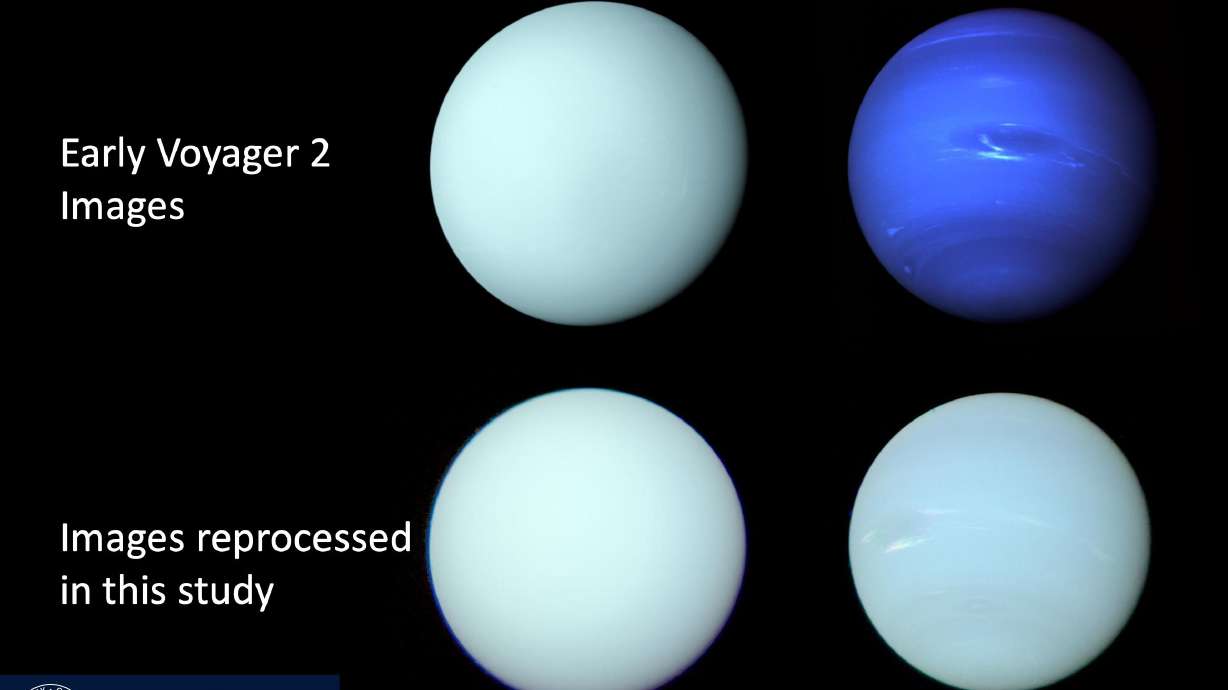Estimated read time: 3-4 minutes
This archived news story is available only for your personal, non-commercial use. Information in the story may be outdated or superseded by additional information. Reading or replaying the story in its archived form does not constitute a republication of the story.
SALT LAKE CITY — Images of Uranus and Neptune captured decades ago and showing the planets, respectively, as light green and bright blue orbs have since become enshrined as our collective vision of those distant members of the solar system.
But a newly released study from scientists at the University of Oxford, who used new imagery data gathered by advanced equipment, have recomputed the depictions of Uranus and Neptune to reveal a markedly different, but much more accurate, representation of the planets as they would appear to the human eye.
Oxford professor Patrick Irwin and his team found that both worlds are in fact a similar shade of greenish blue, despite the commonly held belief that Neptune is a deep azure and Uranus has a pale cyan appearance.
The misrepresentation of the planets' colors tracks back to flyby images captured by the Voyager 2 exploratory spacecraft in the 1980s. Those images were captured in single-color frames that were later recombined to create composite color images, which were, according to Irwin's report, not always accurately balanced to achieve a "true" color rendering of the planets, with the errors frequently showing a shift toward blue.
"Although the familiar Voyager 2 images of Uranus were published in a form closer to 'true' color, those of Neptune were, in fact, stretched and enhanced, and therefore made artificially too blue," Irwin told the Royal Astronomical Society, which published the study's findings.
"Even though the artificially-saturated color was known at the time amongst planetary scientists — and the images were released with captions explaining it — that distinction had become lost over time," Irwin said. "Applying our model to the original data, we have been able to reconstitute the most accurate representation yet of the color of both Neptune and Uranus."
The Oxford research team used data from the Hubble Space Telescope's Space Telescope Imaging Spectrograph and the Multi Unit Spectroscopic Explorer on the European Southern Observatory's Very Large Telescope to re-balance the composite color images recorded by the Voyager 2 camera, and also by the Hubble Space Telescope's Wide Field Camera 3.
The study also provides an answer to a long-standing mystery of why Uranus' color, as viewed from Earth, changes slightly during its 84-year orbit of the Sun.
Irwin and his team analyzed decades of brightness measurements that showed Uranus appears a little greener at its solstices (i.e. summer and winter), when one of the planet's poles is pointed toward the sun. But during its equinoxes — when the sun is over the equator — it has a somewhat bluer tinge.
The variations are due, in part, to Uranus' highly unusual spin.
The planet effectively spins almost on its side during its orbit, meaning that during the planet's solstices, either its north or south pole points almost directly toward the sun and Earth, according to the study.
Researchers also found a way to account for color changes that were caused by a layer of haze, which is actually made up of methane ice particles, that grows particularly thick during Uranus' seasonal transition from equinox to solstice.
Professor Heidi Hammel, of the Association of Universities for Research in Astronomy, who has spent decades studying Neptune and Uranus but was not involved in the study, said the Oxford research findings helped identify the answer to a long-unsolved puzzle.
"The misperception of Neptune's color, as well as the unusual color changes of Uranus, have bedeviled us for decades," Hammel told the Royal Astronomical Society. "This comprehensive study should finally put both issues to rest."










